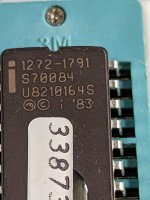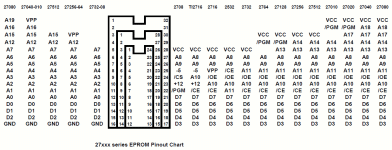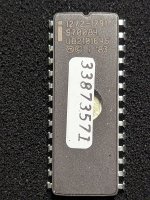Intel used to ( and probably still does ) take, otherwise, bad parts and makes special purpose EPROMs. As an example, say there is one bit that is stuck low out of all the bits. If that particular application is expected to be low, it will then use special marking to indicate that special application. This way, it doesn't completely toss other wise useful parts. The part may be fully functional or have some small number of stuck bits. It would be used for a particular customer or in house application. The marking is so that it can be more easily sorted and stored for that application. As was mentioned, it is likely a standard 27xx pinout.
I often read things like these with care. I always make sure that there is no way that a programming voltage can be connected to the part, in any form. Also some prom programmers use accelerated voltage to read chip manufacturing IDs. These need to be used with care. The older EPROMs don't like these voltages but they can be useful for newer parts like this on with application part numbers.
Like I said, I always make an adapter to ensure that no programming voltage can ever reach the part. Most EPROMs expect the programming input to be at some specific level for reading. I will tie that lead to the required level on the adapter. I usually make adapters from three machine pin sockets that are stacked. This way, I can remove pins by popping them out on the bottom or center layer to ensure that they do not cross connect. I make any need wire cross connects by soldering wire wrap wire from pin to pin and layer to layer. I then press the 3 layers together. I do forget to mark them so I can use them in the future and usually end up making new ones.
It usually isn't a big deal to get address and select pins crossed. If you are not sure if it is expected to be a select, one can just tie it to an address. If it turns out to actually be a select pin and not an address, there will be regular 0FF data in the outputs. By looking at the regular address locations these pop up in the read data file, on can determine if it is a select high or select low. Just pop the adapter apart and rewire that pin to the right level on the top socket. You can also edit the data later to have it make sense.
This way you can read EPROMs and ROM without worry. It just takes a little time but no harm to the part.
Dwight



